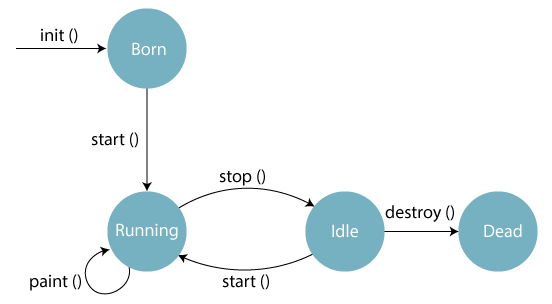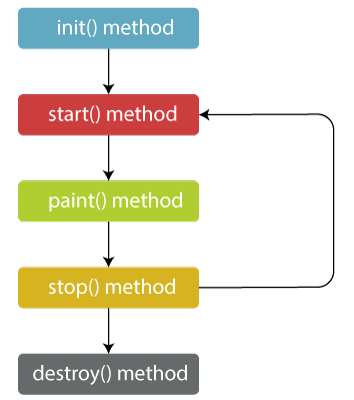Applet Life Cycle in Java
In Java, an applet is a special type of program embedded in the web page to generate dynamic content. Applet is a class in Java.
The applet life cycle can be defined as the process of how the object is created, started, stopped, and destroyed during the entire execution of its application. It basically has five core methods namely init(), start(), stop(), paint() and destroy().These methods are invoked by the browser to execute.
Along with the browser, the applet also works on the client side, thus having less processing time.
Methods of Applet Life Cycle

There are five methods of an applet life cycle, and they are:
- init(): The init() method is the first method to run that initializes the applet. It can be invoked only once at the time of initialization. The web browser creates the initialized objects, i.e., the web browser (after checking the security settings) runs the init() method within the applet.
- start(): The start() method contains the actual code of the applet and starts the applet. It is invoked immediately after the init() method is invoked. Every time the browser is loaded or refreshed, the start() method is invoked. It is also invoked whenever the applet is maximized, restored, or moving from one tab to another in the browser. It is in an inactive state until the init() method is invoked.
- stop(): The stop() method stops the execution of the applet. The stop () method is invoked whenever the applet is stopped, minimized, or moving from one tab to another in the browser, the stop() method is invoked. When we go back to that page, the start() method is invoked again.
- destroy(): The destroy() method destroys the applet after its work is done. It is invoked when the applet window is closed or when the tab containing the webpage is closed. It removes the applet object from memory and is executed only once. We cannot start the applet once it is destroyed.
- paint(): The paint() method belongs to the Graphics class in Java. It is used to draw shapes like circle, square, trapezium, etc., in the applet. It is executed after the start() method and when the browser or applet windows are resized.
Sequence of method execution when an applet is executed:
- init()
- start()
- paint()
Sequence of method execution when an applet is executed:
- stop()
- destroy()
Applet Life Cycle Working
- The Java plug-in software is responsible for managing the life cycle of an applet.
- An applet is a Java application executed in any web browser and works on the client-side. It doesn't have the main() method because it runs in the browser. It is thus created to be placed on an HTML page.
- The init(), start(), stop() and destroy() methods belongs to the applet.Applet class.
- The paint() method belongs to the awt.Component class.
- In Java, if we want to make a class an Applet class, we need to extend the Applet
- Whenever we create an applet, we are creating the instance of the existing Applet class. And thus, we can use all the methods of that class.
Flow of Applet Life Cycle:
These methods are invoked by the browser automatically. There is no need to call them explicitly.

Syntax of entire Applet Life Cycle in Java
|


 For Videos Join Our Youtube Channel: Join Now
For Videos Join Our Youtube Channel: Join Now










